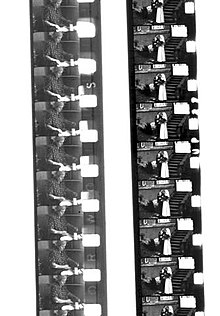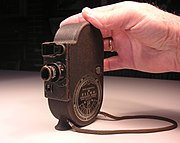8mm film
An 8-mm film is a small film - film format , which for movies and as a small picture film in the photograph is used.
Formats
Double-8 film
Double-8 film is 16 mm wide and perforated on both edges. First half of the film is exposed in the camera, then the second half in the reverse process. After development, the film is cut (split) into two 8 mm wide film strips and glued together. These film strips are referred to as Normal-8-Film (N-8), in English it is called Regular 8 (R-8). Double-8 or N-8 / R-8 is not compatible with Super 8. Double-8-Normal-8 film has the same perforation holes as 16 mm film, but at half the distance. The picture line, that is the dividing line from one picture to the next, lies at the level of a perforation hole. The double-8 film is said to have a better picture position than the super-8 film. The reason for this lies in the perforation hole lying across the edges of the film. Double-8 film is supplied on daylight reels according to ISO 1020. In the 1930s there were 25-foot sheet metal cassettes from Eastman-Kodak and Ansco that were sealed with adhesive tape and that opened the picture window when the camera was closed and vice versa.
The format was introduced in 1932 and it is possible to attach magnetic sound tracks to the film. Today double-8 films are of little importance. The relationship between 8 mm and 16 mm film can be seen in the fact that there are 80 frames on an 8 mm film foot, while there are 40 frames for 16 mm film. Frame rates of 16 fps and 24 fps are common for format 8. Most projectors hold spools for 120 m of film, that is 33 minutes running time at 16 fps. Normal 8 film reels have the same star hole as standard 1/4 ″ tape reels. A normal-8 film spool will not fit on a Super-8 film projector. In the opposite case, an adapter can be used.
Easy-8
Several camera systems have come onto the market for raw film cut to a width of 8 mm. It all started with the Bell & Howell Co.'s film Straight Eight with 30-foot reels in 1935. In 1936 the first Univex camera came out, also with a 30-foot capacity. In 1937 the Agfa-Movex 8 appeared with 10 m loaders. In 1956 there was the Bolsey 8 from the USA for 25 feet of film and around 1960 the KOMZ Ekran 8 from Kazan , Soviet Union with 10 m loaders.
Super 8 films
Super 8 films have a width of 8 mm and are perforated on one side . There is one perforation hole per picture, which is at the height of the center of the picture on the edge. The image field size is 5.36 mm × 4.01 mm (width × height without image line). 72 pictures fall on a single film foot. A film cassette contains 50 feet or 15.24 m of film. With a few camera models (e.g. Nizo 6080, Beaulieu 6008), 60 m film cassettes could also be inserted. The usual speeds at which Super 8 film is recorded and played back are 18 fps and 24 fps. The recorded Super 8 films (e.g. Mickey Mouse cartoons or feature films in a 20-minute short version etc.) were only recorded at 24 fps. Two magnetic sound tracks are possible (for stereo dubbing or duoplay dubbing ). Copies could temporarily be made with optical sound , but there are only a few projectors that are set up for optical sound. Most Super 8 sound film projectors play magnetic sound . The Super 8 film was presented at the Photokina in 1964 ; it has been on the market since 1965.
Silent film projectors for Super 8 usually only had short spool arms, so that only small spools with a capacity of 120 m (approx. 26 minutes at 18 fps) could be used. Sound film projectors usually had at least 180 m of coil capacity, some 240 m. A handful of Super 8 projectors came up with 360 m spool capacity, a single model (Beaulieu 708 EL) with 700 m spools and another (Fumeo Classic S8) with 720 m spools. There were also special spool holders, which supposedly enabled every projector to use 750 m spools, such as As the CSC 750 giant X . The developed films can be mounted with special transparent adhesive strips or a special “wet adhesive”, film putty .
Single 8 movies
Single-8 films are also 8 mm wide and have the same geometry as Super 8, but different cassettes are used which, in contrast to the Super 8 cassette, allow rewinding. The base layer is not triacetate, as is the case with the other films, but PETP polyester. Polyester films (approx. 90 µm) are thinner than acetate films (approx. 135 µm), which means that around 50% more single-8 material fits on a normal Super-8 film spool. Polyester films can only be connected or welded with transparent adhesive strips. However, there are also single-8 films with a carrier layer made of triacetate, such as. B. the black and white reversal film “Retro-X” or the color reversal film “Cinevia”. In these cases, however, only about 12 m of film fit into a cassette. The film pressure plate is part of the camera, not the cassette. The format has been on the market since 1965.
Double Super 8 Films
Double Super 8 films are 16 mm wide and, like Double 8, are perforated on both sides, but according to the Super 8 standard. There are two different systems, 30 m spools for west cameras, 7.5 or 10 m spools for east cameras, an interesting option, as well as single 8, the technical disadvantages of the super 8 Bypass cassette. The format has been on the market since 1966.
Norms
- ISO 486, double-8 raw film dimensions
- ISO 1780, dimensions of the Super 8 cassette
- ISO 2966, dimensions of the double Super 8 raw film
- ISO 3641, dimensions of the single-8 cassette
literature
- Fridolin Schley : The Eighth World: fifty years of Super 8 . Edition Braus, Berlin 2014. ISBN 978-3-86228-098-8 (essay and film stills)
Individual evidence
- ↑ Baumgarten, Martin W .: 8mm Film Gauges (archived page). In: Lavender.fortunecity.com. March 15, 2014, archived from the original on January 23, 2012 ; accessed on July 5, 2018 .





